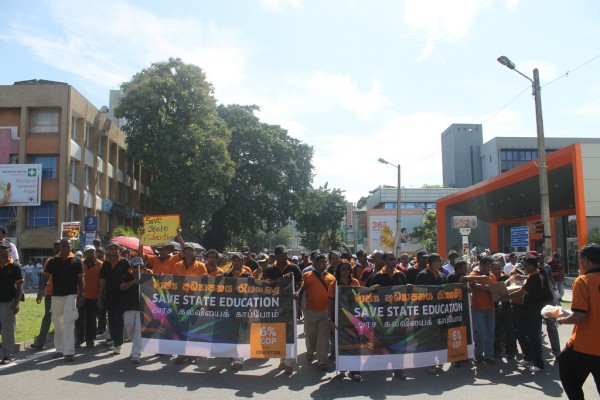Solution to Education Crisis Lies in Encouraging Democratic Discourse, Dialoguing with FUTA and Realigning the Budget to Reflect Constituent Values
By M.A.Sumanthiran M.P.
Teachers and students across the island have
succeeded in securing space in national discourse for Sri Lanka’s
degenerate education system. They have raised fundamental concerns about
the quality of education being provided and the quality of student
being produced.
For three months, nearly 5,000 university professors have been on
strike forgoing their own pay, and all State universities in the country
have been closed indefinitely.
In this context, much of the discussion has come to centre on the
demands of the Federation of University Teachers Association (FUTA),
specifically the demand for the education budget to be increased from
1.9 % to 6 % of Sri Lanka’s GDP.
FUTA’s critics claim 6% is an arbitrary figure. They demand a
detailed plan regarding what the additional funds will be used for, and
how they will solve the problems plaguing Sri Lanka’s education system.
In the critic’s view, answers to these questions are a prerequisite to
action.
Consideration of the critic’s demand reveals an irony. Even as the
demand for 6% circulates and gains grassroots support, Sri Lanka lives
in the current reality of an education allotment of 1.9% of the GDP. The
primary question, then, is not ‘why should we have 6%?’ instead, the
primary question is ‘why do we have 1.9%’? The fact that the 1.9% was
imposed without a detailed plan as to how it would solve the emerging
education crisis, reveals the irony. The critic’s inquiry is thoughtful
and legitimate, it is an echo of FUTA’s own exasperation, and it is best
directed towards the government.
FUTA has stated the 6% figure is symbolic; it is a representation of
the seriousness of their concerns and what they surmise are
proportionately severe demands. FUTA’s stated intention has been to
start a discussion and to frame that discussion in a consequential
light. The grip education has on national discourse, can serve as some
vindication of their method. The figure symbolizes a re-prioritization
of education. While the figure itself serves as a wedge into discourse,
the message the people have come to rally behind, is uncompromising and
clear, the Government of Sri Lanka (GoSL) cannot marginalize education
anymore.
The government’s position was recently defended in a forum discussion by Professor Rajiva Wijesinha. The professor argued a low education budget was actually a counter to ‘Statism’ and served as a de-evolution of the State ‘monopoly of supply’ on education. According to the professor, by decreasing the education budget the government is disentangling itself from the market. Furthermore, the professor argued education must be addressed in isolation, and the topic must not become politicized by other issues.
This position is problematic. Because the debate has been usefully
framed in the context of ‘Per cent GDP’, it is clear that, budgeting a
1.9% of the GDP towards Education is not indicative of de-evolution;
instead, it indicates de-prioritization. Per cent budget is zero-sum; an
increase in one, necessitates a decrease in another, and vice versa. It
is not hard to discover which sectors are being fortified to the
detriment of others.
For example, the government has been steadily increasing the defence
budget. In 2011, the defence budget rose by over 6%, and in 2012, it
rose by 7%. While the government claims these increases were necessary
to pay off old war debts, it is estimated nearly half of the defence
budget is spent maintaining 200,000 military deployments. Keeping 16
out of 19 army divisions in the North and East is costly and education
is paying for it.
The characterization of ‘monopoly of supply’ is also problematic. The
professor assumes if this supply is broken up, it will be met by the
private sector. He points to the success of private universities like
Harvard and Princeton in the USA, to illustrate his point. But in
determining what steps Sri Lanka is to take in developing an education
policy, it becomes important to consider how and why those institutions
were started.

‘Save State Education’, Protest march Moratuwa to Colombo, 2012 September 28, Organized by FUTA-pic: VikalpaSL
Harvard and Princeton were started as seminaries to train Christian
clergy. They were conceived to address a gap in the American market, for
which there was significant demand. Clearly, that gap and demand cannot
be transplanted, but, perhaps, Sri Lanka has its own gap. In fact,
technical and vocational schools are in increasing demand, but
interestingly the private market has failed to meet it. The question
then is, why has the private sector failed in this regard, and what
confidence does that instill, upon which we ought to entrust a larger
share of education? The solution to Sri Lanka’s education crisis is not
necessarily in the private sector. And the private sector cannot be used
as a safety net for government refusal to address inherited
responsibilities.
The professor’s defence of the government position on education did
touch on an important point. ‘Statism’ is a problem, but it is not
limited to education. The Counter to ‘Statism’ is not for the government
to withdraw from providing Education. Instead, the solution lies in
combating Centralism by encouraging democratic discourse, dialoguing
with FUTA and realigning the budget to reflect constituent values. The
democratizing process will bolster both private sector confidence and
public sector efficiency.


 DailyMirror
DailyMirror

